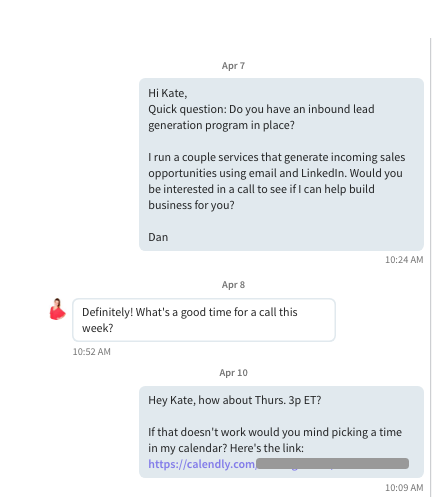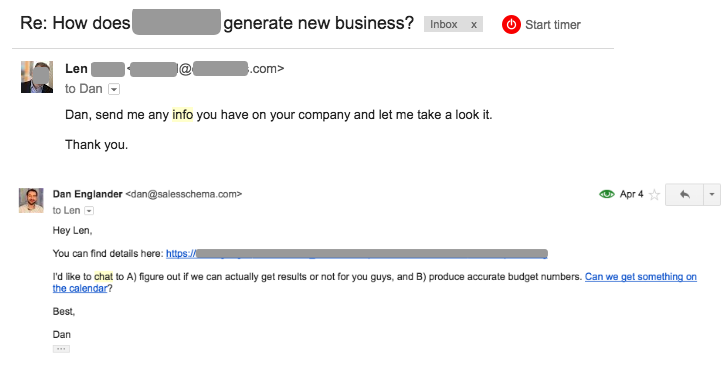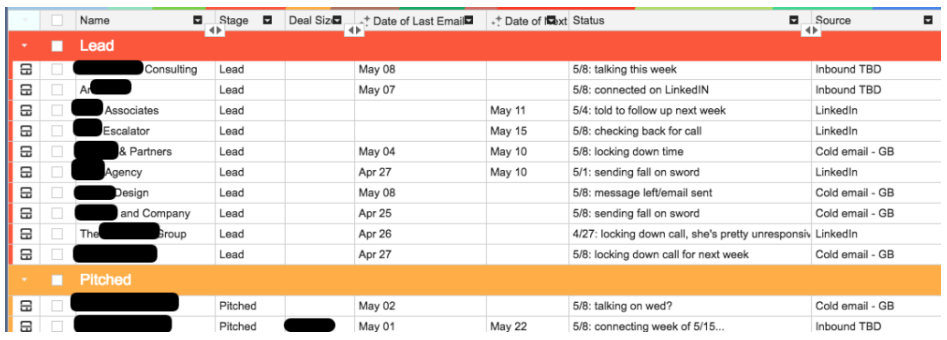Do you want long term retainer engagements, quiet headache-free workdays, and compelling projects?
Do you want to work with dream clients who match the strategic vision for your agency?
Then why wait for them to come to you? Why not go out and find them instead of waiting for them to straggle into the contact form on your website?
But first, you have to get over the most common limit beliefs that are holding you back…
“Once we get them on the phone, we’re damn good at closing them!”
That’s the sort of braggadocio I hear when I ask agency owners about their sales effectiveness.
Most of the time, they’re basing their stellar track record on referrals and other late-stage buyers.
If you’re like most agencies, you generate new business through your personal network or inbound marketing channels like SEO and advertising.
When you’re talking to buyers who are decided on a specific solution, it’s not uncommon for you to experience close rates of more than 50%, and liken yourself a Tony Robbins-level master of persuasion.
The inbound prospects you’re selling to are usually at the vendor selection phase of the buying process. That means they’re problem aware, ie. “Traffic is low, and we need to win 3x more customers for our B2B SaaS platform by end of Q4”.
Also, your inbound prospects are typically decided on a solution to alleviate their pain ie. “We need a multi-channel strategy that includes digital and traditional advertising.”
Now, in the vendor selection phase, all they have to do is find the right agency to execute, ie. “Let’s see what agencies are in my network or happen to come across my radar this week…”
At this point, you might be wondering why you should step out of the comfortable hot tub of warm inbound prospects. After all, they’re ready to buy, and they’re closing at high rates!
There’s a simple yet underappreciated dynamic that’s killing your growth.
The Goldilocks Problem
The Goldilocks Problem happens when your buyers are selecting a vendor, which is typically when you’ll hear that knock on your door. Your prospect will find a few providers, put them in a spreadsheet, and find the one that’s not too hot, not too cold, but just right.
Maybe you’re thinking, “Ok, Dan, but our marketing and/or relationships make us into trusted advisors, and makes clients choose to work with us without even considering competitors.”
That’s awesome when it happens, but those prospects tend to be the exception, not the norm. When it comes to marketing services, there are multitudes of options, and by the time a prospect is reaching out, you’re made into a line time in a price comparison spreadsheet. Even if you’re not facing competitors at the start, chances are you will be before long – after all, the client came to you knowing what solution is required, and that means they know they can switch out providers with relative ease.
Once you’re in that spreadsheet, you’re in a commoditized race to the bottom, and the only way to win is not to play.
The hidden problems of relying on marketing and referrals alone.
While marketing and referrals should be a part of your overall strategy, if they are the only thing in your arsenal, you’re hindering your business in a big way.
Here are the threats few think to consider:
Inconsistent and slow results.
Referrals for one are unpredictable, and marketing takes a lot of experimentation and might take months or years to produce actual conversations with ideal prospects. You simply can’t afford to keep your pipeline anything less than full. Your sales cycle takes weeks or months, and when your activity drops off you’re setting yourself up for a big dip toward the famine trough of the feast and famine rut.
Distorted view of sales skills.
The more subtle and insidious problem with relying on referrals and marketing alone is that these strategies give you a distorted view of your sales process and its effectiveness, and by extension, your value proposition to the market as a whole. As covered earlier, you might think you have your sales process dialed in when you’re closing more than half the people you talk to, but in reality, it’s because most of the decisions were made long before the prospect was aware of your existence.
Limited control over who your clients and revenue.
Marketing and referrals leave you with very limited control over the types of clients you’re able to work with. You’re at the mercy of whoever decides to hit you up. You can get super targeted with ads or content, but your control is still minimal at the end of the day.
The challenges of hunting.
The Savannah is a harsh place, but its rewards are well worth it. You will have to hunt with a bow and arrow for your food, but once you know how to do it, you’ll never go hungry again.

What to expect on the Savannah
You will have to be persistent.
You’re the one entering your prospect’s world, so you will have to break through the noise.
You might send a cold email and get them scheduled for a discovery call, only to have them flake or go silent. That usually means they’re busy, not disinterested.
You will have to build trust.
Tied to the last point, you will have to establish yourself as someone worth listening to. One of the most straightforward ways is niching and demonstrating experience in your prospect’s vertical.
You will have to teach.
Remember, your prospect will typically be at the beginning of their journey, and they probably won’t be problem or solution-aware.
You will need to convince them of the solution before you sell them on what makes you the best in your world. This is best done through teaching, and getting them to think differently. The reaction you’re going for is, “I’ve never thought of it that way!”
For more on this teaching-based approach, which is ideal for all types of sales conversations, check out The Challenger Sale.
You will have to offer a valuable and legible differentiator.
Once your prospect is convinced of the solution, you must demonstrate what makes you the best in the world (even if your world is quite small).
Determining your differentiator is not always straightforward, and it may take some thinking (or assistance from companies like ours), but below you’ll the common traps to avoid.
We hear these all the time the time from our new clients on our kick off calls, and the problem is that these selling points, while they may be true, are NOT perceived as valuable or different to the market.
“We’re very creative, and we come up with fresh and original ideas.”
“We’re very hands-on, and we provide exceptional service.”
“We work with very experienced people, and our quality level is very high.”
By the time the buyer experiences these differentiators, they’ve been working with you for months, so the don’t help you from a new business perspective.
You will have to take control.
You must have a simple, well-defined sales process that moves your prospect forward. This means proactively suggesting the next step, and getting buy-in from decision makers until paying you becomes the final logical option.
Aim for close rates of 10-20%.
You will have to talk to ten people to close one of them. Goldilocks time is over, and this is where you’ll finally sharpen your skills and take your sales game to a new level.
Intimidated yet? Not to worry! Once you get into the rhythm of being proactive to hunt down new business, it will be as natural as every other aspect of your business.
Here’s how to get started.
How to ensure you win new business sooner rather than later.
To take command of your future revenues, clients, and peace of mind, you must go hunting. The best tools for this are outbound email, LinkedIn, the phone, and any other medium that allows you control over who you contact and how you contact them.
First, you have to get your prospect to raise their hand and show genuine interest in your offering. This is the service we provide to our clients on a ‘done for you’ basis, and I’ve created a lot of materials about how you can DIY some aspects of it – check out the opt-in at the bottom of this page.
But what comes next after your prospect raises his hand and shows interest?
What’s the best way to move the conversation forward?
After all, there are so many possibilities…
This following won’t tell you everything you need to know to excel at business development and sales, but it will give you all the best practices for initiating your sales process effectively.
Be responsive.
Check your email and/or LinkedIn inboxes 1+ times per day. Just like fresh fruit or warm pastries, and unlike wine, time is not a positive force on warm prospects, and responsiveness is key.
Make chatting easy and effortless.
In marketing land, you may choose to warm up leads with articles, reports, ROI calculators, and other materials, but not in sales land, which is where we’re hanging out.
You’ve specifically identified a shortlist of people who are just right for your value proposition, you’ve put the basic info in front of them, and now it’s time to talk. In one way or another, our message will invite your prospects to join on a discovery call.
From there, once they are interested, making the call happen can be a straightforward road at times and a slightly winding path at other times.
How to make sure the discovery call happens:
Option A: Suggest a few specific times to speak.
Option B: Suggest a specific time and use your calendar link as a backup.

Example from LinkedIn.
Option C: Use your calendar link only, but sell it a bit.

Let your prospect know it’s for convenience, and what happens after they book a time, otherwise they may disregard your fancy contraptions.
The phone is your friend.
Always go for the shortest path to a real conversation. You might be worried that prospects will get annoyed, but in our experience, most appreciate the convenience of a quick impromptu call over the annoyance of online scheduling. Just be sure to ask if it’s a good time, and remind them how you connected.
Persistence is your friend.
Sometimes you’ll hear salespeople whine that if a prospect is not serious enough to comply and get on the phone right away, they probably aren’t serious and won’t buy. From thousands of sales conversations, we know this couldn’t be further from the truth. Assuming that a prospect is a bad fit when they go quiet assumes facts not in evidence. The usual explanation is that they are busy, and it might take a few nudges to break through the noise. You will matter to them, but not until you make yourself matter.
Use content as a fallback, not a lead-in.
Sometimes your prospects will ask for more information before speaking. When this happens, go ahead and throw them a bone, but don’t get caught in a time-consuming text conversation. Politely push for a phone conversation, and demonstrate that the meeting is in your prospect’s best interest. After all, your prospect is asking for more info to reduce the risk that we will sign up for a long winded, boring, irrelevant, or pushy sales pitch. Consider how you can most quickly mitigate that risk.

You can set a hard ending to the text merry go round by asking for specificity: send the info, then ask what else they would like to see before agreeing to speak.
If all else fails, don’t be afraid to pick up the phone once they show interest.
How to handle the flake factor.
A common situation: the prospect shows interest and then goes silent. From experience in thousands of situations, we know flaking to most commonly be a symptom of busyness, not disinterest. If we or our clients gave up at the first (or second flake), we’d be foregoing a major percentage of our closed business.
How to handle flaking:
Step 1. Keep track of leads in your CRM so you can time out follow-ups as needed.
Also, follow up tools like Rebump can be helpful.
CRM example from Streak:

Step 2. Follow up over the phone.
Prioritize mobile over the office line.
Step 3. If needed, leave a short, succinct VM.
A missed call alone is viewed as unimportant and worth ignoring.
Step 4. Follow up over email ~30 minutes later.
You can schedule this to go out later so you can keep working your pipeline without interruption.
Step 5. Make them make the decision NOT to speak to you.
After a couple unsuccessful follow-ups, reach out, refresh them on the benefit and why they agreed to speak and ask if you should take them off your radar.
Consistency is everything.
Be proactive and going hunting will give you command over your business that you’ve yet to experience, but you have to be consistent. It’s kinda like going to the gym.








